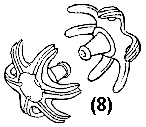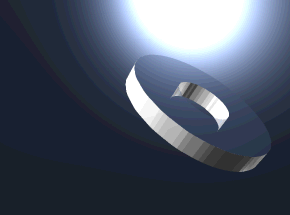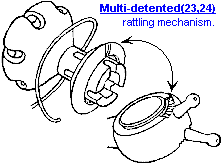|
|
|
|
|
|
|
|
 |
The assembled stators (7a) and the contact terminals (7b) in the coil formers (10) are held in place by spacer rings (11), which also serve as bushes forming a hydrodynamic gas bearing with the rotor (4) spindle and act as 'crash barriers' in the event of string breakage. |
 |
Terminal Crowns Designed to spread the load of the string tension over the outer faces of the piezos and to protect them and the string bend-around section: large
animated exploded plans |
|
|
|
 |
|
Manual pressure control assembly (12,13,14,17) enables mercury to be drawn into the central chamber for start-up. When priming is complete the chamber is emptied, admitting air. Parts (17) are copper rings, set in the plastic handle to provide (a) a manual protective short-turn screen and (b) together with Pin (14) an attempt to directionally focus any fields of unknown provenance (the best I could do in the face of the uncertain). Pin (14) is for fine adjustment of chamber pressure and, slightly flexible, is of magnetostrictive alloy to aid system resonance. |
| Piezoelectric transducer elements mounted within the piston coil formers are of an industrial standard design, polarised in their depth/thickness vector and silvered on their flat circular faces to act as electrical terminals, making contact in assembly with terminal crowns (8) and wound-in ends of string (where string is used as coils). |
 |
|
Capacitive spike discretion is maintained by the shape of the exponential cavity formed between these components (7a, 7b), when joined in assembly. Any rotor spoke ball-end, in passing the flat face of stator (7a), experiences this discrete spike. Maximum field compression occurs at the exact coaxial centre of the string. |
Mounted to spin freely at the octave node of a speaking length of the string, the four-spoke (aluminium) rotor is synchronously driven, magnetically and electrostatically, by a reciprocal system of coils and stators. Two sets of three stators are arranged either side of the rotor. These may be rotated out of mutual alignment, thus initialising harmonic multiplication in the string's vibration. Resonant feedback is supported within the system by piezoelectric transducer elements bearing the string's tension (which is slight). Voltages transduced are passed to induction coils, wound of the same type of string. |
|
 |
Seeding energy for initial rotation may come from manual stimulation. This is achieved by use of a rattling mechanism (23,24) or, conversely, by any externally applied electromagnetic alternating field from a separate power supply. Such is the sensitivity of a taut music string that, in air, human vocal drone power will also serve this purpose. Providing a suitable resonance is adjusted for and set, the rotor will be induced to spin and in the absence of any further stimulation, that said rotation and vibration will decay over a period of several seconds. |
|
|